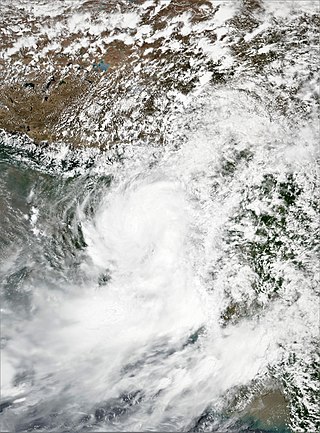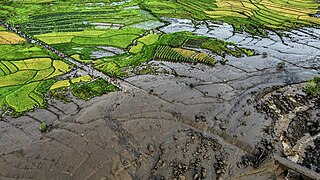Related Research Articles

The 2006–2007 Southeast Asian floods were a series of floods that mostly affected Malaysia from 18 December 2006 to 13 January 2007. The floods were caused by above average rainfall, which was attributed to Typhoon Utor (2006) which had hit the Philippines and Vietnam a few days earlier. By the third week of January 2007, Johor had been affected by a larger flood. Singapore and certain parts of Indonesia were flooded due to the same typhoon.

In October 1999, severe flooding affected portions of eastern Mexico and Central America. Rainfall in September preceded the primary event in Mexico, which moistened soils. On October 4, Tropical Depression Eleven developed in the Gulf of Mexico, which drew humidity from the gulf and the Pacific Ocean to produce torrential rainfall in mountainous regions of eastern Mexico, reaching 43.23 in (1,098 mm) in Jalacingo, Veracruz. This was the third-highest tropical cyclone-related rainfall total in Mexico from 1980–2006, and the event caused the highest rainfall related to tropical cyclones in Veracruz, Hidalgo, and Puebla. In some locations, the daily rainfall represented over 10% of the annual precipitation total. The heaviest rainfall occurred in mountainous regions that were the mouths of several rivers. A broad trough absorbed the depression on October 6, and rainfall continued for the next few days. Additional rainfall occurred in Tabasco state on October 18. The floods were estimated as a 1 in 67 year event in one location, although such floods are expected to affect eastern Mexico twice per century, the last time being 1944.

The 2010 Ugandan landslide occurred in the Bududa District in eastern Uganda on 1 March 2010. The landslide was triggered by heavy rain between 12 pm and 7 pm that day. At least 100 people were believed to have been killed, and 94 bodies were found.

The 2010 China floods began in early May 2010. Three hundred and ninety-two people died, and a further 232 people were reported missing as of June 30, 2010, including 57 people in a landslide in Guizhou. Fifty-three of the deaths occurred from the flooding and landslides between May 31 and June 3, and 266 deaths occurred between June 13 and June 29. Four hundred and twenty four people were killed by the end of June, including 42 from the Guizhou landslide; 277 more were killed and 147 were missing in the first two weeks of July, bringing the death toll as of August 5 to 1,072. A landslide in early August in Gansu killed at least 1,471 people and left 294 missing. In total, the flooding and landslides killed at least 3,185 people in China by August 31. More than 230 million people in 28 provinces, municipalities, and regions, especially the southern and central provinces and regions of Zhejiang, Fujian, Jiangxi, Hubei, Hunan, Guangdong, Guangxi, Chongqing Municipality, Gansu, Sichuan, and Guizhou, and the northeastern province of Jilin were affected, while at least 4.66 million people were evacuated because of the risk of flooding and landslides in the latter half of June. By early August, over 12 million people were evacuated, and that number rose to 15.2 million by August 31.
The 2010 Nigerien floods were floods across Niger which left over 111,000 people homeless. Niger was already suffering acute food shortages following prolonged drought in the Sahel region. As of 24 August 2010, at least 6 to 8 people had died. The Niger river was pushed to its highest levels in 80 years. The floods subsequently spread along the River Niger into Nigeria, Ghana, Burkina Faso, Togo and Benin over the next few months. Later storms also brewed up in the CAR, Morocco and northern Algeria.

The 2013 Jakarta flood was a flood in Jakarta, the capital of Indonesia, which, in addition to areas in downtown Jakarta, also affected several other areas surrounding the city, such as West Java and Banten.

Flooding in Jakarta occurs on the northwest coast of Java, at the mouth of the Ciliwung River on Jakarta Bay, which is an inlet of the Java Sea and has happened recently in 1996, 1999, 2007, 2013, and 2020.

On 30 July 2014, a landslide occurred in the village of Malin in the Ambegaon taluka of the Pune district in Maharashtra, India. The landslide, which hit early in the morning while residents were asleep, was believed to have been caused by a burst of heavy rainfall, and killed at least 151 people. Rains continued after the landslide making rescue efforts difficult.
The following lists events that happened during 2014 in Indonesia.
Beginning on 14 December 2014, a series of floods from the northeast monsoon hit Indonesia, West Malaysia, Southern Thailand, and later Sri Lanka in South Asia. More than 100,000 people were evacuated in Indonesia, 200,000 in Malaysia, and several thousand in Thailand. Floods also affected 1,100,000 in Sri Lanka.

On 12 June 2017, heavy monsoon rain triggered a series of landslides and floods in Rangamati, Chittagong and Bandarban - three hilly districts of Bangladesh - and killed at least 152 people. The weather also caused power cuts and telecommunications disruptions, making it difficult for rescuers to reach affected communities. Reaz Ahmed, head of Bangladesh's Disaster Management Department, said the landslides were the worst in the country's history.

In late June through mid-July 2018, successive heavy downpours in southwestern Japan resulted in widespread, devastating floods and mudflows. The event is officially referred to as Heisei san-jū-nen shichi-gatsu gōu by the Japan Meteorological Agency. As of 20 July, 225 people were confirmed dead across 15 prefectures with a further 13 people reported missing. More than 8 million people were advised or urged to evacuate across 23 prefectures. It is the deadliest freshwater flood-related disaster in the country since the 1982 Nagasaki flood when 299 people died.
2019 (MMXIX) was a common year starting on Tuesday of the Gregorian calendar, the 2019th year of the Common Era (CE) and Anno Domini (AD) designations, the 19th year of the 3rd millennium and the 21st century, and the 10th and last year of the 2010s decade.

The 2019 Papua protests were a series of protests by Papuans in Indonesia that began on 19 August 2019 and mainly took place across Indonesian Papua region in response to the arrests of 43 Papuan students in Surabaya, East Java for alleged disrespect of the Indonesian flag. Many of the protests involved thousands of participants, and some grew from local protests in Surabaya to demanding an independence referendum for the whole region. In several locations, the protests turned into general riots, resulting in the destruction of government buildings in Wamena, Sorong and Jayapura. Clashes between protesters and police resulted in injuries, with over 30 people killed from both the clashes and the rioting.

Indonesia is an island country in Southeast Asia and Oceania, located in the Pacific Ocean and the Indian Ocean. The largest island nation in the world, the country is the home of over seventeen thousand islands.
On February 6, 2024, a landslide occurred in Maco, Davao de Oro, Philippines, after heavy rainfall, killing at least 98 people.

Beginning on 11 May 2024, heavy rain caused flash floods and lahars in West Sumatra, Indonesia, killing at least 67 people and leaving 20 more missing. More than 4,000 people were also displaced. The regencies of Agam and Tanah Datar were most affected.
References
- 1 2 3 4 "Indonesia president to visit Papua disaster zone". Radio New Zealand International . 2010-10-12. Retrieved 2010-10-12.
- ↑ "Floods and landslides kill at least 86 in Indonesia". BBC News . 2010-10-06. Retrieved 2010-10-12.
- 1 2 "Aid for Papuan Flood Victims Being Sent to Wrong Place, Red Cross Says". Jakarta Globe . 2010-10-12. Archived from the original on 2010-10-20. Retrieved 2010-10-12.
- ↑ 'Wasior victims to receive makeshift houses', The Jakarta Post, 3 December 2010.
- ↑ Maulia, Erwida (2010-10-12). "IndGovt blames rain, not deforestation". Jakarta Post . Retrieved 2010-10-12.